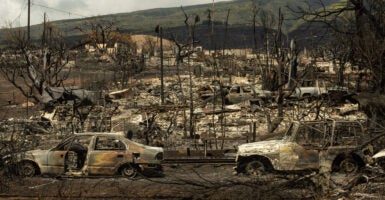Hawaii has suffered through one of the most devastating natural disasters in recent American history.
Predictably, the left-wing political and media narrative-making machine has sought to turn the Hawaii fires into another lesson about climate change.
The facts draw a drastically different picture.
The extent of the damage on the island of Maui isn’t fully known yet, but it looks horrific. As of this writing, the death toll stands at 99. It’s the fifth-deadliest fire in American history and the deadliest in a century. Property-damage dollar estimates have been estimated at just under $6 billion, but they will likely rise.
The oceanside town of Lahaina appears to have been completely devastated, much like how several California towns were devastated by fires in 2018 and 2021.
As with all disasters—man-made or natural—the Left never lets a crisis go to waste. In this case, you guessed it, the message from Democrats and their media allies is that the fires are a result of climate change.
“I think that we very much need to acknowledge that climate change is upon us,” Sen. Mazie Hirono, D-Hawaii, said in a Sunday interview with CNN’s Jake Tapper. “There are whole states, by the way, Jake, where you can’t even use the words ‘climate change’ because they still have a head-in-the-sand attitude.”
Kaniela Ing, a native Hawaiian and national director of the Green New Deal Network, of course leaned hard into that same message.
“Anyone in power who denies climate change, to me, are the arsonists here,” Ing said. “We’re living the climate emergency.”
Hawaii Gov. Josh Green, a Democrat, said that it was “very real” climate change that caused the conditions for the fires.
Amazingly, President Joe Biden has said almost nothing about the fire. When asked by a Bloomberg reporter what he thought of the situation in Hawaii, Biden said only, “No comment.” Apparently, he is on vacation again.
But since Biden’s a Democrat, he won’t be called a racist for his callousness.
This may come as a shock, but members of the far-left “Squad” in Congress want to use this moment to declare a “climate emergency” so they can start imposing their will on the country.
But is there any truth to those claims?
The reality is that the increased prevalence of huge, destructive fires has been largely the product of poor forest management. In the U.S. and Canada, a combination of environmentalism, general neglect, and government incompetence has put many regions in an increased state of fire danger.
Fires are going to happen. Huge, towering infernos that engulf whole regions are much more preventable.
As Elise McCue wrote in an excellent report for The Daily Signal, Maui has been at high risk for big fires due to many factors. The disappearance of Hawaii’s sugar cane and agricultural industry is a big one. Many former sugar cane fields have been taken over by large stretches of dry, flammable grass.
According to Anthony Watts, a senior fellow at the Heartland Institute, the topography of Maui creates particularly dry conditions on large parts of the island and high winds. So, you have an enormous amount of fuel and dry conditions in a region that—global warming or not—gets quite hot.
This was a tinderbox—and a huge catastrophe waiting to happen.
What’s infuriating in the case of Hawaii is that state officials had been warned about this problem for years.
“In 2014, a wildfire-protection plan for the area was written by the Hawaii Wildfire Management Organization, a nonprofit that works with government agencies,” according to The Wall Street Journal. “It warned that Lahaina was among Maui’s most fire-prone areas because of its proximity to parched grasslands, steep terrain and frequent winds.”
According to the Journal, the plan—which included state officials—laid out clear measures to protect Lahaina from fire. It recommended “thinning vegetation near populated areas, improving wildfire-response capabilities, and working with landowners and utilities to help reduce fire risk on their property.”
These recommendations were more than reasonable, but they appear to have been half-completed, at best.
It’s important to note that Hawaii has been beset by public corruption for a long time, and there are plenty of signs that the state wasn’t exactly prepared to meet the challenge of a predictable big fire.
In 2018, a missile alert went out to residents of the state that said, “BALLISTIC MISSILE THREAT INBOUND TO HAWAII. SEEK IMMEDIATE SHELTER. THIS IS NOT A DRILL.”
It created a panic on the island and made national news.
One man was blamed for the incident and fired. But now it seems like there might have been a bigger issue than just a single government worker not doing his job correctly.
Five years later and the warning sirens that were supposed to alert residents of Lahaina about the fire never went off. Instead, the warning system “relied on a series of sometimes confusing social media posts,” according to The Associated Press.
“Some survivors have reported receiving no warning messages before the fire reached them, while others said messages appeared and then disappeared from their mobile phones, and they couldn’t find instructions,” The Wall Street Journal reported.
Not great.
Just as with the fake missile alert, the Hawaii Emergency Management Agency oversaw the fire emergency system.
“Nobody at the state and nobody at the county attempted to activate those sirens based on our records,” Hawaii Emergency Management Agency spokesman Adam Weintraub acknowledged.
What exactly went wrong?
The answer so far has been that the fires were burning too fast.
“It was largely a function of how fast the flames were moving,” Weintraub said, referring to the failure of emergency management officials to trigger the sirens. “They were trying to coordinate response on the ground, and they had already issued these other alert systems.”
This isn’t exactly a satisfying answer for why a massively expensive alert system designed to warn residents of a huge fire or other emergency completely failed in a serious emergency.
It seems the problems in Hawaii have little to do with climate change and a whole lot more to do with human error and bad policies.
A responsible national and local press would be digging more into those issues than leaning into the usual climate change propaganda.
Have an opinion about this article? To sound off, please email [email protected] and we’ll consider publishing your edited remarks in our regular “We Hear You” feature. Remember to include the url or headline of the article plus your name and town and/or state.































One Reply to “Deadly Hawaii Fires Are Result of Political and Policy Failures—Not Climate Change”